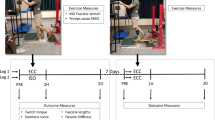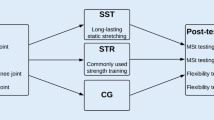Abstract
Stretching is usually part of warm-up routines in many sports, but it affects the subsequent muscle force; therefore, it could negatively influence post-activation potentiation (PAP), one of the warm-up’s main effects. The aim of this study was to evaluate the acute effects of passive stretching on PAP and fibre conduction velocity (CV). Seven subjects underwent 2 experimental sessions, control (C) and stretching (S), each consisting of 2 series (7 min resting) of 3 maximal voluntary contractions (MVC) of biceps brachii (5 s isometric contraction, 10 s recovery). During the resting phase of the S session, the biceps brachii was passively stretched (5×45 s stretches, 15 s recovery). Root mean square (RMS), mean frequency (MF) and CV were calculated from electromyography. Peak torque (pT) and half-contraction time (1/2CT) were measured and normalised by the arm muscular area (pTn). After C, pTn increased and 1/2CT decreased (p<0.05); moreover, MF and CV increased (p<0.05). After S, 1/2CT increased (p<0.05) and RMS decreased (p<0.05). Passive stretching could blunt the effects of PAP, presumably due to mechanical and neuromuscular changes. The observed changes in CV suggest a possible decrease in Ca2+ sensitivity in contractile proteins. Therefore, the use of passive stretching in warm-up routines remains questionable.
Similar content being viewed by others
References
Bishop D (2003) Warm up I: potential mechanisms and the effects of passive warm up on exercise performance. Sports Med 33:439–454
Baudry S, Duchateau J (2007) Postactivation potentiation in a human muscle: effect on the rate of torque development of tetanic and voluntary isometric contractions. J Appl Physiol 102:1394–1401
Gleim GW, McHugh MP (1997) Flexibility and its effects on sports injury and performance. Sports Med 24:289–299
Guissard N, Duchateau J (2004) Effect of static stretch training on neural and mechanical properties of the human plantar-flexor muscles. Muscle Nerve 29:248–255
Fowles JR, Sale DG, MacDougall JD (2000) Reduced strength after passive stretch of the human plantarflexors. J Appl Physiol 89:1179–1188
Cornwell A, Nelson AG, Sidaway B (2002) Acute effects of stretching on the neuromechanical properties of the triceps surae muscle complex. Eur J Appl Physiol 86:428–434
Evetovich TK, Nauman NJ, Conley DS, Todd JB (2003) Effect of static stretching of the biceps brachii on torque, electromyography, and mechanomyography during concentric isokinetic muscle actions. J Strength Cond Res 17:484–488
Bussel B, Pierrot-Deseilligny E (1977) Inhibition of human motoneurons, probably of Renshaw origin, elicited by an orthodromic motor discharge. J Physiol 269:319–339
Taylor DC, Dalton JD Jr, Seaber AV, Garrett WE Jr (1990) Viscoelastic properties of muscle-tendon units. The biomechanical effects of stretching. Am J Sports Med 18:300–309
Jones DA (1981) Muscle fatigue due to changes beyond the neuromuscular junction. Ciba Found Symp 82:178–196
Jones DA, Newham DJ, Torgan C (1989) Mechanical influences on long-lasting human muscle fatigue and delayed-onset pain. J Physiol 412:415–427
Proske U, Morgan DL (1999) Do cross-bridges contribute to the tension during stretch of passive muscle? J Muscle Res Cell Motil 20:433–442
Farina D, Ferguson RA, Macaluso A, De Vito G (2007) Correlation of average muscle fiber conduction velocity measured during cycling exercise with myosin heavy chain composition, lactate threshold, and VO2max. J Electromyogr Kinesiol 17:393–400
Sakamoto K, Li W (1997) Effect of muscle length on distribution of muscle fiber conduction velocity for M. biceps brachii. Appl Human Sci 16:1–7
Poole DC, Musch TI, Kindig CA (1997) In vivo microvascular structural and functional consequences of muscle length changes. Am J Physiol 272:H2107–H2114
Vandervoort AA, Quinlan J, McComas AJ (1983) Twitch potentiation after voluntary contraction. Exp Neurol 81:141–152
Behm DG, Button DC, Butt JC (2001) Factors affecting force loss with prolonged stretching. Can J Appl Physiol 26:261–272
Magnusson SP, Simonsen EB, Aagaard P et al (1996) A mechanism for altered flexibility in human skeletal muscle. J Physiol 497:291–298
Hermens HF, Merletti R, Stegeman D et al (1999) European Recommendations for Surface Electromyography
Cramer JT, Housh TJ, Johnson GO et al (2004) Acute effects of static stretching on peak torque in women. J Strength Cond Res 18:236–241
Rubini EC, Costa AL, Gomes PS (2007) The effects of stretching on strength performance. Sports Med 37:213–224
Knudson D, Bennett K, Corn R et al (2001) Acute effects of stretching are not evident in the kinematics of the vertical jump. J Strength Cond Res 15:98–101
Bazett-Jones DM, Winchester JB, McBride JM (2005) Effect of potentiation and stretching on maximal force, rate of force development, and range of motion. J Strength Cond Res 19:421–426
Nelson AG, Guillory IK, Cornwell C, Kokkonen J (2001) Inhibition of maximal voluntary isokinetic torque production following stretching is velocity-specific. J Strength Cond Res 15:241–246
Avela J, Finni T, Liikavainio T et al (2004) Neural and mechanical responses of the triceps surae muscle group after 1 h of repeated fast passive stretches. J Appl Physiol 96:2325–2332
Guissard N, Duchateau J, Hainaut K (2001) Mechanisms of decreased motoneurone excitation during passive muscle stretching. Exp Brain Res 137:163–169
Rassier DE, Macintosh BR (2002) Length-dependent twitch contractile characteristics of skeletal muscle. Can J Physiol Pharmacol 80:993–1000
Rosenbaum D, Hennig EM (1995) The influence of stretching and warm-up exercises on Achilles tendon reflex activity. J Sports Sci 13:481–490
Magnusson SP, Aagard P, Simonsen E, Bojsen-Moller F (1998) A biomechanical evaluation of cyclic and static stretch in human skeletal muscle. Int J Sports Med 19:310–316
Kubo K, Kanehisa H, Kawakami Y, Fukunaga T (2001) Influence of static stretching on viscoelastic properties of human tendon structures in vivo. J Appl Physiol 90:520–527
Cramer JT, Housh TJ, Weir JP et al (2005) The acute effects of static stretching on peak torque, mean power output, electromyography, and mechanomyography. Eur J Appl Physiol 93:530–539
Cramer JT, Beck TW, Housh TJ et al (2007) Acute effects of static stretching on characteristics of the isokinetic angle-torque relationship, surface electromyography, and mechanomyography. J Sports Sci 25:687–698
Guissard N, Duchateau J, Hainaut K (1988) Muscle stretching and motoneuron excitability. Eur J Appl Physiol Occup Physiol 58:47–52
Chalmers G (2004) Re-examination of the possible role of Golgi tendon organ and muscle spindle reflexes in proprioceptive neuromuscular facilitation muscle stretching. Sports Biomech 3:159–183
Houk JC, Singer JJ, Henneman E (1971) Adequate stimulus for tendon organs with observations on mechanics of ankle joint. J Neurophysiol 34:1051–1065
Guissard N, Duchateau J (2006) Neural aspects of muscle stretching. Exerc Sport Sci Rev 34:154–158
Bigland-Ritchie B, Furbush F, Woods JJ (1986) Fatigue of intermittent submaximal voluntary contractions: central and peripheral factors. J Appl Physiol 61:421–429
Brody LR, Pollock MT, Roy SH et al (1991) pH-induced effects on median frequency and conduction velocity of the myoelectric signal. J Appl Physiol 71:1878–1885
Author information
Authors and Affiliations
Corresponding author
Rights and permissions
About this article
Cite this article
Cè, E., Rampichini, S., Maggioni, M.A. et al. Effects of passive stretching on post-activation potentiation and fibre conduction velocity of biceps brachii muscle. Sport Sci Health 4, 43–50 (2008). https://doi.org/10.1007/s11332-008-0066-2
Received:
Accepted:
Published:
Issue Date:
DOI: https://doi.org/10.1007/s11332-008-0066-2




